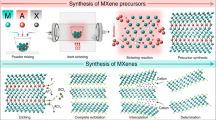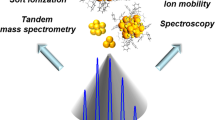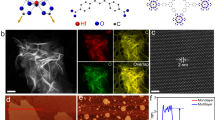Abstract
The MXene family of two-dimensional transition metal carbides and nitrides already includes ~50 members with distinct numbers of atomic layers, stoichiometric compositions and solid solutions, in-plane or out-of-plane ordering of atoms, and a variety of surface terminations. MXenes have shown properties that make them attractive for applications ranging from energy storage to electronics and medicine. Although this compositional variability allows fine-tuning of the MXene properties, it also creates challenges during the analysis of MXenes because of the presence of multiple light elements (for example, H, C, N, O, and F) in close proximity. Here, we show depth profiling of single particles of MXenes and their parent MAX phases with atomic resolution using ultralow-energy secondary-ion mass spectrometry. We directly detect oxygen in the carbon sublattice, thereby demonstrating the existence of oxycarbide MXenes. We also determine the composition of adjacent surface termination layers and show their interaction with each other. Analysis of the metal sublattice shows that Mo2TiAlC2 MAX exhibits perfect out-of-plane ordering, whereas Cr2TiAlC2 MAX exhibits some intermixing between Cr and Ti in the inner transition metal layer. Our results showcase the capabilities of the developed secondary-ion mass spectrometry technique to probe the composition of layered and two-dimensional materials with monoatomic-layer precision.
This is a preview of subscription content, access via your institution
Access options
Access Nature and 54 other Nature Portfolio journals
Get Nature+, our best-value online-access subscription
$29.99 / 30 days
cancel any time
Subscribe to this journal
Receive 12 print issues and online access
$259.00 per year
only $21.58 per issue
Buy this article
- Purchase on Springer Link
- Instant access to full article PDF
Prices may be subject to local taxes which are calculated during checkout




Similar content being viewed by others
Data availability
All relevant data are available from the authors on reasonable request, and/or are included within the Article and the Supplementary Information.
References
Gogotsi, Y. & Huang, Q. MXenes: two-dimensional building blocks for future materials and devices. ACS Nano 15, 5775–5780 (2021).
Naguib, M., Barsoum, M. W. & Gogotsi, Y. Ten years of progress in the synthesis and development of MXenes. Adv. Mater. 33, 2103393 (2021).
VahidMohammadi, A., Rosen, J. & Gogotsi, Y. The world of two-dimensional carbides and nitrides (MXenes). Science 372, eabf1581 (2021).
Kim, H. & Alshareef, H. N. MXetronics: MXene-enabled electronic and photonic devices. ACS Mater. Lett. 2, 55–70 (2020).
Shekhirev, M., Shuck, C. E., Sarycheva, A. & Gogotsi, Y. Characterization of MXenes at every step, from their precursors to single flakes and assembled films. Prog. Mater. Sci. 120, 100757 (2021).
Benninghoven, A. Developments in secondary ion mass spectroscopy and applications to surface studies. Surf. Sci. 53, 596–625 (1975).
Gnaser, H. SIMS detection in the 1012 atoms cm−3 range. Surf. Interface Anal. 25, 737–740 (1997).
Stevie, F. A. & Griffis, D. P. Quantification in dynamic SIMS: current status and future needs. Appl. Surf. Sci. 255, 1364–1367 (2008).
Emziane, M., Durose, K., Halliday, D. P., Bosio, A. & Romeo, N. In situ oxygen incorporation and related issues in CdTe/CdS photovoltaic devices. J. Appl. Phys. 100, 013513 (2006).
Pazniak, H. et al. Ion implantation as an approach for structural modifications and functionalization of Ti3C2Tx MXenes. ACS Nano 15, 4245–4255 (2021).
Wang, C.-Y. et al. Topological design of ultrastrong MXene paper hosted Li enables ultrathin and fully flexible lithium metal batteries. Nano Energy 74, 104817 (2020).
Wustoni, S. et al. MXene improves the stability and electrochemical performance of electropolymerized PEDOT films. APL Mater. 8, 121105 (2020).
Lorencova, L. et al. Electrochemical performance of Ti3C2Tx MXene in aqueous media: towards ultrasensitive H2O2 sensing. Electrochim. Acta 235, 471–479 (2017).
Clegg, J. B. Secondary ion mass spectrometry—a practical handbook for depth profiling and bulk impurity analysis Wiley, New York, 1989. Surf. Interface Anal. 17, 221 (1991).
Vandervorst, W. Semiconductor profiling with sub-nm resolution: challenges and solutions. Appl. Surf. Sci. 255, 805–812 (2008).
Michałowski, P. P. et al. Precise localization of contaminants in graphene with secondary ion mass spectrometry. Measurement 187, 110308 (2022).
Michałowski, P. P. et al. Defect-mediated sputtering process of boron nitride during high incident angle low-energy ion bombardment. Measurement 179, 109487 (2021).
Michałowski, P. P., Caban, P. & Baranowski, J. Secondary ion mass spectrometry investigation of carbon grain formation in boron nitride epitaxial layers with atomic depth resolution. J. Anal. At. Spectrom. 34, 848–853 (2019).
Michałowski, P. P. et al. Growth of highly oriented MoS2 via an intercalation process in the graphene/SiC(0001) system. Phys. Chem. Chem. Phys. 21, 20641–20646 (2019).
Jiang, B., Huang, K., Cao, Z. & Zhu, H. Thermodynamic study of titanium oxycarbide. Metall. Mater. Trans. A 43, 3510–3514 (2012).
Zhang, B., Xiao, J., Jiao, S. & Zhu, H. A novel titanium oxycarbide phase with metal-vacancy (Ti1–yCxO1–x): structural and thermodynamic basis. Ceram. Int. 47, 16324–16332 (2021).
Prikhna, T. et al. Presence of oxygen in Ti-Al-C MAX phases-based materials and their stability in oxidizing environment at elevated temperatures. Acta Phys. Pol. A 133, 789–793 (2018).
Colonna, F. & Elsässer, C. First principles DFT study of interstitial hydrogen and oxygen atoms in the MAX phase Ti2AlN. RSC Adv. 7, 37852–37857 (2017).
Sang, X. et al. Atomic defects in monolayer titanium carbide (Ti3C2Tx) MXene. ACS Nano 10, 9193–9200 (2016).
Mathis, T. S. et al. Modified MAX phase synthesis for environmentally stable and highly conductive Ti3C2 MXene. ACS Nano 15, 6420–6429 (2021).
Rosen, J. et al. Oxygen incorporation in Ti2AlC thin films. Appl. Phys. Lett. 92, 064102 (2008).
Persson, P. O. Å., Rosén, J., McKenzie, D. R. & Bilek, M. M. M. Formation of the MAX-phase oxycarbide Ti2AlC1–xOx studied via electron energy-loss spectroscopy and first-principles calculations. Phys. Rev. B 80, 092102 (2009).
Mockute, A., Dahlqvist, M., Hultman, L., Persson, P. O. Å. & Rosen, J. Oxygen incorporation in Ti2AlC thin films studied by electron energy loss spectroscopy and ab initio calculations. J. Mater. Sci. 48, 3686–3691 (2013).
Dahlqvist, M., Alling, B., Abrikosov, I. A. & Rosén, J. Phase stability of Ti2AlC upon oxygen incorporation: a first-principles investigation. Phys. Rev. B 81, 024111 (2010).
Persson, I. et al. How much oxygen can a MXene surface take before it breaks? Adv. Funct. Mater. 30, 1909005 (2020).
Tran, M. H. et al. Experimental and theoretical investigation of the chemical exfoliation of Cr-based MAX phase particles. Dalton Trans. 49, 12215–12221 (2020).
Maleski, K., Shuck, C. E., Fafarman, A. T. & Gogotsi, Y. The broad chromatic range of two-dimensional transition metal carbides. Adv. Opt. Mater. 9, 2001563 (2021).
Hart, J. L., Hantanasirisakul, K., Gogotsi, Y. & Taheri, M. L. Termination-property coupling via reversible oxygen functionalization of MXenes. ACS Nanosci. Au https://doi.org/10.1021/acsnanoscienceau.2c00024 (2022).
Hu, T., Yang, J. & Wang, X. Carbon vacancies in Ti2CT2 MXenes: defects or a new opportunity? Phys. Chem. Chem. Phys. 19, 31773–31780 (2017).
Kamysbayev, V. et al. Covalent surface modifications and superconductivity of two-dimensional metal carbide MXenes. Science 369, 979–983 (2020).
Wang, H.-W., Naguib, M., Page, K., Wesolowski, D. J. & Gogotsi, Y. Resolving the structure of Ti3C2Tx MXenes through multilevel structural modeling of the atomic pair distribution function. Chem. Mater. 28, 349–359 (2016).
Hu, T. et al. Chemical origin of termination-functionalized MXenes: Ti3C2T2 as a case study. J. Phys. Chem. C 121, 19254–19261 (2017).
Kim, Y.-J. et al. Etching mechanism of monoatomic aluminum layers during MXene synthesis. Chem. Mater. 33, 6346–6355 (2021).
Anasori, B. et al. Two-dimensional, ordered, double transition metals carbides (MXenes). ACS Nano 9, 9507–9516 (2015).
Hantanasirisakul, K. et al. Evidence of a magnetic transition in atomically thin Cr2TiC2Tx MXene. Nanoscale Horiz. 5, 1557–1565 (2020).
Acknowledgements
This work was supported by the National Science Centre (NCN) within SONATA 14 2018/31/D/ST5/00399 and National Centre for Research and Development (NCBR) within LIDER XII LIDER/8/0055/L-12/20/NCBR/2021 projects. MXene synthesis and characterization conducted at Drexel University were supported by the US Department of Energy (DOE), Office of Science, Office of Basic Energy Sciences, grant no. DE-SC0018618. M.A. was supported by the National Science Foundation Graduate Research Fellowship under grant no. DGE-1646737 and the US Department of Education Graduate Assistance in Areas of National Need (GAANN) fellowship. Any opinions, findings, and conclusions or recommendations expressed in this material are those of the author(s) and do not necessarily reflect the views of the National Science Foundation. The SEM and XRD analyses were performed using instruments in the Materials Characterization Core at Drexel University. We thank B. Anasori (IUPUI, USA) for preparing the Mo2TiAlC2 and Cr2TiAlC2 MAX samples.
Author information
Authors and Affiliations
Contributions
T.S.M. prepared the MAX samples. M.A. prepared the MXene samples. P.P.M. established the measurement procedures and carried out the SIMS experiments. P.P.M., S.K. and A.W. interpreted the SIMS results. I.J., A.P., M.M., A.M., R.D. and E.W. provided the additional SEM, FTIR and XRD characterization data, which were needed to establish the SIMS measurement procedure. M.A. performed the SEM, XRD and optical microscopy analyses for the MAX and MXenes. P.P.M., M.A., T.S.M., S.K., A.W., K.H. and Y.G. wrote the manuscript with suggestions and comments from all the authors. P.P.M. supervised the SIMS analysis and Y.G. supervised the MAX and MXene analyses. P.P.M. and Y.G. planned and supervised the entire project.
Corresponding authors
Ethics declarations
Competing interests
The authors declare no competing interests.
Peer review
Peer review information
Nature Nanotechnology thanks the anonymous reviewers for their contribution to the peer review of this work.
Additional information
Publisher’s note Springer Nature remains neutral with regard to jurisdictional claims in published maps and institutional affiliations.
Supplementary information
Supplementary Information
Supplementary Figs. 1–10, Table 1 and Discussion.
Rights and permissions
Springer Nature or its licensor holds exclusive rights to this article under a publishing agreement with the author(s) or other rightsholder(s); author self-archiving of the accepted manuscript version of this article is solely governed by the terms of such publishing agreement and applicable law.
About this article
Cite this article
Michałowski, P.P., Anayee, M., Mathis, T.S. et al. Oxycarbide MXenes and MAX phases identification using monoatomic layer-by-layer analysis with ultralow-energy secondary-ion mass spectrometry. Nat. Nanotechnol. 17, 1192–1197 (2022). https://doi.org/10.1038/s41565-022-01214-0
Received:
Accepted:
Published:
Issue Date:
DOI: https://doi.org/10.1038/s41565-022-01214-0
This article is cited by
-
Comprehensive synthesis of Ti3C2Tx from MAX phase to MXene
Nature Protocols (2024)
-
MXene-based electrochemical devices applied for healthcare applications
Microchimica Acta (2024)
-
The global expansion of MXenes
Graphene and 2D Materials (2023)
-
Affordable combustion synthesis of V2AlC precursor for V2CTx MXene
Graphene and 2D Materials (2023)
-
Two-dimensional MXenes and their applications
Frontiers of Physics (2023)



